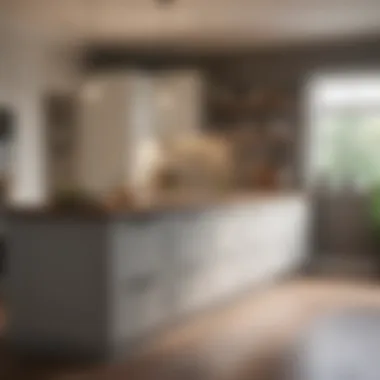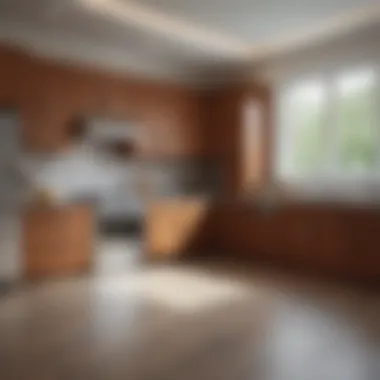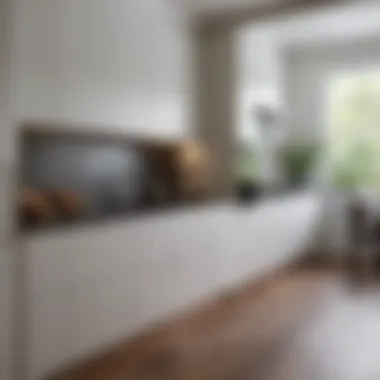A Comprehensive Guide to Level 1 Kitchen Cabinets


Intro
Level 1 kitchen cabinets serve as foundational elements in kitchen design. They are often the first choice for many homeowners due to their cost-effectiveness and versatility. Understanding the characteristics of these cabinets helps in making informed choices. This guide explores not just the materials and styles available but also the installation processes and necessary maintenance. By analyzing these aspects, readers can navigate the complexities involved in selecting the ideal cabinetry for their kitchen layout.
Key Insights and Trends
Current trends in interior design
In recent years, there has been a noticeable shift towards minimalism in interior design. Homeowners prefer clean lines, simple shapes, and functional spaces where everything has a purpose. Level 1 kitchen cabinets reflect this trend by offering straightforward designs without excessive ornamentation. The focus is on versatility—these cabinets can fit various aesthetic preferences from modern to traditional.
Natural materials have also gained popularity. Many homeowners are now choosing wood over synthetic options for its durability and environmental benefits. Oak and maple are frequently installed for their strength and beauty. Advancements in finishes provide options that enhance the natural grain, fostering warmth in the kitchen environment.
Popular selection styles
Selecting the right style influences not only the look but also the feel of a kitchen. Shaker-style cabinets remain a favored choice due to their simple yet elegant design. These cabinets often feature a recessed panel, adding character without overwhelming the space. On the other hand, flat-panel cabinets are gaining traction among those who lean toward a sleek modern vibe, as they offer a seamless appearance that is easy to clean.
Color choices also play a significant role. Neutral shades like white, gray, and beige dominate the contemporary palette, but deeper hues like navy and forest green are becoming popular for those wanting to make a statement.
Practical Tips and How-To Guides
Step-by-step guides for cabinet installation
Installing level 1 kitchen cabinets can seem daunting, but with careful planning and the right tools, it is achievable:
- Measure your space. Accurate measurements are critical to ensure cabinets fit snugly in the designated area.
- Choose the layout. Determine if you want a U-shape, L-shape, or galley layout based on your kitchen space and usability.
- Prepare the walls. Ensure they are clean and level, adding shims if necessary to create a stable base.
- Mark the locations. Outline where each cabinet will go to visualize the work ahead.
- Install cabinets. Start with the corner unit and work outward. Secure them to the wall using screws, ensuring they are level.
- Add finishing touches. Attach doors and hardware. Adjust hinges to ensure everything aligns perfectly.
Maintenance tips
Caring for level 1 kitchen cabinets involves routine cleaning and periodic deep cleaning. Here are some essential maintenance tips:
- Wipe down regularly. Use a damp cloth with mild soap to keep surfaces clean. Avoid harsh chemicals that could damage the finish.
- Prevent water damage. Immediate removal of spills is crucial, particularly for wooden cabinets.
- Check for loose hardware. Periodically inspect hinges and knobs, tightening them as necessary to keep doors functioning smoothly.
Regular maintenance not only enhances longevity but also preserves the beauty of your cabinets.
Understanding Level Kitchen Cabinets
Understanding Level 1 kitchen cabinets is crucial for anyone interested in kitchen design and functionality. These cabinets serve as the backbone of a kitchen, influencing both aesthetics and usability. They are particularly appealing to homeowners looking for affordable yet functional options. Level 1 kitchen cabinets are designed to provide basic storage while ensuring a level of durability and style.
The significance of this topic lies in the implications for both budgeting and design choices. When you comprehend the essence of Level 1 cabinets, you can make informed decisions that align with your specific needs and preferences. This guide not only delves into their defining features but also reviews the variations among different cabinet levels, enhancing your understanding of what options truly suit your kitchen.
The importance continues with the realization that choosing the right cabinetry can enhance the overall impact of your kitchen, contributing to a more efficient cooking environment and a visually appealing space.
Definition of Level Kitchen Cabinets
Level 1 kitchen cabinets refer to the most basic tier of cabinetry available on the market. They are typically constructed using lower-grade materials, including particle board and less expensive types of plywood. The focus is on delivering fundamental style and utility, often without the more complex features found in higher-level cabinets.
These cabinets usually come in standard sizes and are straightforward in design. They usually lack intricate moldings or custom finishes, making them more budget-friendly for homeowners. Some common features of Level 1 cabinets include flat fronts and basic hardware. However, they are designed to meet essential needs, making them a popular choice for many.
Distinction Between Cabinet Levels
Understanding the distinction between cabinet levels is key in evaluating your choices. Level 1 cabinets are designed with simplicity and cost-effectiveness in mind. In comparison, Level 2 and Level 3 cabinets incorporate more advanced features, such as better materials and construction techniques.
Some of the main differences you may encounter include:
- Materials Used: Higher-grade cabinets often use solid hardwood or premium-grade plywood, enhancing durability.
- Construction Quality: Advanced joinery techniques contribute to sturdiness in better-quality cabinets, while Level 1 relies on simpler assembly methods.
- Customization Options: Higher levels offer a variety of finishes and styles, whereas Level 1 provides limited options.
Overall, knowing these distinctions helps homeowners to choose cabinetry that meets their functional and aesthetic needs without overspending.
Characteristics of Level Cabinets


Understanding the characteristics of level 1 kitchen cabinets is vital for homeowners and designers alike. These cabinets are often the foundation of kitchen aesthetics and functionality. The selection of cabinets can greatly influence both usability and style in the kitchen. By delving into the material composition, construction quality, and finishes, one can appreciate the nuances that define level 1 cabinets.
Material Composition
Material composition is an essential aspect of level 1 kitchen cabinets. It affects not only the appearance but also the durability and cost.
Types of Wood Used
The types of wood commonly used in level 1 cabinets often include oak, maple, and pine. Oak is favored for its sturdiness, making it a long-lasting choice. Maple offers a smoother grain, which adds a refined look. Pine, being softer, is usually more affordable. While oak and maple are excellent choices for both aesthetics and durability, pine may show wear more quickly. The key characteristic here is the balance between visual appeal and practical longevity.
Composite Materials
Composite materials, such as engineered wood or MDF, are crucial in the market for level 1 cabinets. These materials are made from wood fibers that are glued and pressed together, densely packed to create a solid product. This is a popular option due to its affordability and uniform surface. It can be more resistant to warping compared to solid wood. However, composite materials can be less durable in the long run if exposed to excess moisture, making them more suitable for low-humidity environments.
Construction Quality
The construction quality of cabinets directly impacts their lifespan and functionality. Understanding joinery techniques and sustainability considerations can help in making informed choices.
Joinery Techniques
Joinery techniques indicate how the pieces of the cabinet come together. Techniques such as dovetail joints or mortise and tenon joints are renowned for their strength. Good joinery enhances the structural integrity of the cabinets, leading to longevity. However, more complex joinery often raises the production costs. Products with simpler joinery might be more affordable but could lack in durability and overall quality. Examining joinery techniques should be a priority for anyone investing in kitchen cabinets.
Sustainability Considerations
Sustainability considerations are increasingly important in today’s marketplace. Level 1 cabinets can often be found made from sustainably sourced wood or recycled materials. Choosing cabinets that emphasize sustainability can greatly reduce environmental impact. Such choices not only benefit the planet but also often align with modern consumer preferences. However, it is worth noting that sustainably sourced materials might have a higher upfront cost, which is a trade-off many consumers are willing to accept for longer-term benefits.
Finishes and Styles
The finishes and styles selected for level 1 cabinets influence their visual appeal. Comparing painted versus stained finishes and identifying cabinet styles available can lead to better design choices.
Painted vs. Stained Finishes
Painted finishes offer a wide spectrum of color choices, allowing for more customization. They can provide a vibrant and contemporary look, making them highly desirable in modern kitchens. On the other hand, stained finishes highlight the natural beauty of the wood grain, bringing warmth and character. The downside of painted finishes is their susceptibility to chipping while stains may require more careful maintenance to prevent fading over time. Therefore, the choice between these finishes should be based on aesthetic preference as well as practical concerns.
Cabinet Styles Available
There are various cabinet styles available, including shaker, flat-panel, and traditional raised-panel designs. Shaker cabinets are recognized for their simple, clean lines, making them a timeless choice. Flat-panel designs offer sleek modernity, appealing to minimalist tastes. Traditional raised-panel cabinets feature more decorative elements and may resonate well with classic themes. The best style choice should reflect the overall kitchen design. Cabinet style significantly shapes the room's character, contributing to cohesion or contrast within the kitchen space.
Design Considerations
When it comes to kitchen cabinetry, design considerations are paramount. Selecting the right cabinets can dictate not only the aesthetic appeal of your kitchen but also its overall functionality. The style, color, and layout you choose will have enduring implications on how the space feels and operates. A thoughtful approach to design can enhance efficiency and harmony in this vital household area.
Selecting the Right Style for Your Kitchen
Modern Aesthetics
Modern aesthetics have gained significant traction in recent years. Characterized by clean lines, minimal ornamentation, and sleek finishes, modern kitchens offer a streamlined look that feels open and uncluttered. This style emphasizes functionality and simplification, making it an appealing choice for many homeowners.
The unique feature of modern aesthetics lies in their ability to integrate technology seamlessly. For instance, built-in appliances blend into cabinetry, providing a cohesive appearance. The benefits include ease of maintenance due to fewer intricate designs that can collect dirt. However, some may find modern styles lacking warmth, which can make the kitchen feel less inviting.
Traditional Styles
Traditional styles evoke a sense of history and warmth. They often incorporate rich woods, detailed moldings, and classic finishes. This approach can create a cozy and welcoming environment that is highly appealing to families and individuals who enjoy a timeless look.
The key characteristic of traditional styles is their attention to detail. This often includes raised panel doors and decorative accents. The unique feature is how these styles can harmonize with various types of decor, from rustic to elegant. However, they may require more maintenance due to intricate designs, which can accumulate dust and grime more than more modern options.
Color Schemes and Visual Impact
Color schemes play a vital role in the overall visual impact of kitchen cabinets. Choosing the right colors can enhance the mood of the kitchen. Lighter shades can create an illusion of space and brightness, while darker colors can add depth and sophistication.


Using contrasting elements, such as pairing light cabinets with dark countertops, can provide an eye-catching aesthetic while maintaining coherence. Additionally, the use of color can be an expression of personal style. Homeowners should consider how different colors will interact with natural and artificial light throughout the day.
Functional Layouts
Open Concept Kitchens
Open concept kitchens utilize space efficiently by integrating dining and living areas with the kitchen. This layout encourages social interactions while cooking and can create a more inviting environment.
The benefit of open concepts is the sense of freedom and spaciousness they provide. It allows for better traffic flow, making it ideal for gatherings. However, careful consideration must be placed on noise levels, as cooking sounds can disrupt conversations in nearby areas.
Galley Style Layouts
Galley style layouts are known for their efficiency, utilizing two parallel walls for cabinetry and appliances. This design is particularly effective in smaller spaces, allowing for ample storage and functionality.
The key characteristic of a galley kitchen is that everything is within easy reach, reducing steps required during cooking. This layout can also be more economical, as it requires less space compared to other styles. However, the confined nature may feel limiting for those who value openness, and careful planning is essential to prevent it from feeling cramped.
Effective design considerations can significantly enhance both the aesthetic and functional aspects of level 1 kitchen cabinets. Whether you are drawn to modern aesthetics or traditional styles, understanding these elements will guide your cabinetry choices.
Installation Process
The installation process for level 1 kitchen cabinets is crucial. Proper installation ensures that cabinets are functional, safe, and aesthetically pleasing. Understanding this process aids homeowners in achieving a well-designed space. When done correctly, it enhances the longevity of the cabinets and the overall satisfaction with the kitchen design. Therefore, careful attention must be given to each step involved in the installation process.
Preparation and Planning
Measuring the Space
Measuring the space is a fundamental aspect of planning for cabinet installation. This step involves calculating the dimensions of the kitchen. Accurate measurements can significantly impact the final outcome. It helps prevent issues like misalignment or gaps. A key characteristic of measuring the space is its simplicity. With basic tools like a tape measure and a notepad, homeowners can gather necessary dimensions.
A unique feature of this task is its adaptability. Depending on the kitchen layout, different measuring techniques may apply. This flexibility offers advantages like optimizing layout and maximizing storage. However, some disadvantages include the potential for human error, leading to incorrect measurements and, subsequently, ill-fitted cabinets. Therefore, greater care in this phase is essential to inform further steps.
Removing Old Cabinets
Removing old cabinets is another vital preparation step in the installation process. This task prepares the kitchen for new cabinets. A main characteristic of removing old cabinets is the opportunity it provides to assess the existing space. Homeowners can identify potential repairs or modifications needed before new cabinets are installed.
The unique feature of this step is its necessity. It helps reflect on the past design and consider improvements. This can be a beneficial choice for various reasons, including increasing overall kitchen functionality and aesthetics. One drawback could be the labor intensity involved. Additionally, removing cabinets could reveal underlying issues like water damage that require attention before moving forward with the installation of new cabinets.
Installation Steps
Leveling and Securing Cabinets
Leveling and securing cabinets is an essential step in the installation process. It ensures that each cabinet is properly aligned and securely fastened. A key characteristic of leveling cabinets is that it contributes to both the functionality and appearance. Cabinets that are not level can create problems during use, such as doors not closing properly.
A unique aspect of this step is the tools involved, such as a level and clamps. This precision in installation promotes durability and ease of use. However, challenges may arise if the floor is uneven, requiring additional adjustments that could complicate the installation process.
Installing Hardware
The final step in the installation sequence is installing hardware like handles and hinges. This task impacts the utility and look of the cabinets. A central aspect of installing hardware is customization; the choice of hardware can change the whole feel of the kitchen. Homeowners can choose styles and finishes that align with their design preferences.
The unique feature of this installation is how it enhances functionality. Properly installed hardware supports smooth operation of cabinet doors. Nevertheless, it requires precision, as improperly installed hardware can lead to early wear and tear. Thus, balancing aesthetic choices and practical considerations is crucial during this step.
Cost Considerations
Understanding the financial implications of installing level 1 kitchen cabinets is essential for homeowners and designers. Costs influence decisions greatly and can determine the suitability of cabinetry in varying kitchen designs. By examining the budgeting aspect, the cost vs. value analysis, and efficiency in spending, one can better allocate resources inline with practical desires.
Budgeting for Level Cabinets
Material Costs
Material costs play a pivotal role in determining the overall budget for level 1 cabinets. Generally, these cabinets are made from several materials. Plywood and MDF (medium-density fiberboard) are common choices.


The key characteristic of material costs is their scalability. This means that they may vary widely based on type and quality. For homeowners, the significance of choosing the right material lies not only in aesthetics but also in durability.
One unique feature of these materials is that plywood cabinets provide a good balance between cost and sturdiness. This makes them a popular choice for homeowners who prioritize longevity without overspending. However, lower-grade materials may lead to wear and tear more quickly. The disadvantages of opting for cheaper materials are mainly visible in the cabinet's lifespan and initial appearance.
Labor Costs
Labor costs are another significant factor when budgeting for level 1 cabinets. Installing cabinets properly requires time and skill. The key characteristic here is that skilled labor can enhance the quality of installation, which impacts the longevity of cabinets.
One reason homeowners might regard labor costs as a beneficial investment is that improper installation can result in early damage or uneven surfaces. Contractors, for example, have experience ensuring a smooth finish, ensuring cabinets function effectively.
However, labor costs can add considerable sums to the total expenditure. Homeowners should assess whether to engage professionals or consider DIY strategies. While DIY commitment can indeed save money, it may fail to deliver the same level of quality as a professional job. This presents a clear advantage and disadvantage in assessing labor costs.
Cost vs. Value Analysis
Evaluating the cost versus the long-term value of level 1 cabinets brings clarity to the decision-making process. Factors such as resale value, durability, and aesthetic appeal must be considered.
Investing in quality cabinets may increase the home's resale value, making it a strategic financial decision. Homeowners looking for immediate efficiency might overlook costs upfront. However, understanding how quality influences long-term satisfaction can shift that perspective.
When thinking about value, options should align closely with specific use cases for the kitchen space. For instance, durable materials can lead to lower maintenance and replacement costs over time.
In summary, understanding both costs and the potential value helps homeowners strike a balance between realistic budgeting and aspiration for a functional, aesthetically pleasing kitchen.
Maintenance and Care
Proper maintenance and care of level 1 kitchen cabinets is essential for extending their life and maintaining their appearance. Regular cleaning and addressing signs of wear can significantly enhance the functionality and aesthetic appeal of the kitchen. Understanding how to maintain cabinets effectively is a worthwhile investment for homeowners and designers alike, ensuring that the cabinetry remains a cornerstone of kitchen design for years to come.
Cleaning Techniques
Keeping level 1 kitchen cabinets clean is necessary to ensure their longevity and optimal performance. Here are some effective cleaning methods:
- Mild Dish Soap: Mix warm water with a few drops of mild dish soap. Use a soft cloth to gently wipe the surfaces, making sure to avoid excessive moisture which can damage the finish.
- Vinegar Solution: For tougher grime, a solution of equal parts water and white vinegar can work wonders. This solution helps to cut through grease without harsh chemicals.
- Avoid Abrasives: Steer clear of abrasive pads or cleaners. They can scratch the surface and ruin the finish.
It’s also wise to clean spills immediately. Food, grease, or moisture left unattended can lead to stains or damage over time.
Signs of Wear and How to Address Them
Recognizing and addressing signs of wear on level 1 cabinets is crucial to preserving their integrity. Here are some common signs:
- Fading Paint or Stain: Over time, exposure to sunlight can cause finishes to fade. To counteract this, consider using window treatments to block direct sunlight during peak hours.
- Peeling or Bubbling: If the finish begins to peel or bubble, it may indicate moisture damage. In such cases, carefully sanding the affected area and then applying a fresh coat of paint or stain can remedy the situation.
- Warped Doors: Changes in humidity can cause doors to warp or swell. If this occurs, it may be possible to realign the hinges, but severe cases may require replacement.
Addressing these concerns promptly can prevent further damage and extend the life of kitchen cabinets.
Longevity of Level Cabinets
The lifespan of level 1 kitchen cabinets largely depends on material quality, usage, and maintenance. With proper care, these cabinets can last for several years.
- Quality Materials: Cabinets made from high-quality wood or composite materials typically last longer than those made from inferior options. Therefore, it’s crucial to consider the material when selecting cabinets.
- Regular Maintenance: Following the cleaning techniques and addressing signs of wear as discussed can greatly increase longevity. Regular check-ups can identify potential issues before they become significant problems.
- Environmental Factors: Factors like humidity and temperature fluctuation play a role in the lifespan of the cabinets. Maintaining a stable environment and avoiding excess moisture is essential.
"Investing in the maintenance of your level 1 kitchen cabinets can provide lasting benefits that permeate throughout your kitchen space."
In summary, the care and maintenance of level 1 kitchen cabinets can ensure they remain functional and visually appealing over time. Homeowners should commit to a maintenance routine focused on cleaning, recognizing wear, and preventing long-term damage to prolong the life of their kitchen cabinetry.
Culmination
Understanding the importance of level 1 kitchen cabinets can significantly impact your kitchen's overall design and functionality. This article has delved into various elements of level 1 cabinets, highlighting characteristics, materials, installation processes, and maintenance tips. Emphasizing these aspects allows homeowners and designers to make informed decisions that cater to their specific needs.
Summarizing Key Points
To recap, level 1 kitchen cabinets present a practical and cost-effective choice for many homeowners. They typically feature simpler materials and finishes, yet offer a range of styles that can complement different kitchen designs. The construction quality is adequate for everyday use, making them a preferred option for budget-conscious individuals who do not want to sacrifice functionality. Key takeaways include:
- Material options often include plywood, MDF, and particle board, each with distinct benefits and drawbacks.
- Standard finishes in level 1 cabinets can be painted or stained, providing options that appeal to various aesthetics.
- The installation process is generally straightforward, making them an attractive option for DIY enthusiasts.
Final Thoughts on Level Kitchen Cabinets
In the evolution of kitchen design, level 1 cabinets hold a fundamental place. They balance affordability and practicality, making them a sensible choice for many kitchen renovations. As you consider what type of cabinetry suits your space, remember that even basic options can effectively serve your functional needs and align with your style preferences. Choosing the right set of cabinets could enhance not only the look of your kitchen but also its usability, ultimately reflecting your personal taste and lifestyle. Whether you are hosting gatherings or enjoying quiet meal times alone, well-selected kitchen cabinets can make a noticeable difference in daily living.



